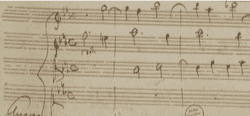A leapfrog, a term coined by Gjerdingen, is a contrapuntal technique typically involving two upper voices above a bass. Consider the following realisation of the fourth verset in G major by the Bolognese counterpoint master Stanislao Mattei (1750–1825). (For more information on Mattei and his pedagogy see Partimento Practice:

As you can see, the middle voice begins on beat 1 of bar 1 with a dotted half note on ➊, followed by a quarter note on ➐ on beat 4. Consider this ➊–➐ snippet the ‘theme’ of this technique. Rather than waiting for the middle voice to complete its presentation, the upper voice enters ‘too early’ —in stretto—on the dot of the dotted half note (mid-bar 1), producing the ‘theme’ one scale step higher and creating a 2–3 suspension.
The middle voice, in turn, does not wait for the upper voice to finish either, but leaps up a fourth to ➌ to restate the ‘theme’ on the next downbeat (of bar 2), now a third higher than its first iteration, thereby creating a temporary voice crossing —notice how the middle voice ends up above the upper voice. Half a bar later, in bar 2b, order is restored as the upper voice leaps up a fourth in turn. This leapfrogging process continues until the upper voice reaches ➏ bar 3b.
As a result of this voice leading, notice further:
- The scalar ascent from ➊ to ➏, carried out alternatively by the middle and upper voices, respectively;
- The chain of 2–3 suspensions, with dissonant 2nds on the strongs beats and the consonant 3rds (the resolutions) on the weak beats (except in bar 1a);
- The alternation between the ‘correct’ relative position of the upper voices in the first halves of bars and their inverted position in the second halves.
(Notice also how the remainder of the verset —starting in bar 3b– is built on a descending chain of 2–3 suspensions, during which the relative position of the upper voices remains ‘correct’. In this passage, the upper voice outlines a complete stepwise descent from ➏ to ➊, while the middle voice descents stepwise from ➎ to ➐, before rising to ➊ to end in unison with the upper voice.)
To open the Recordare from his Requiem KV 626, Mozart employs a leapfrog, but sets it in 3/4, with each ‘theme’ lasting two bars instead of one. In this case, each next entry comes in on the next downbeat and adds an extra ornamental note at the end of the ‘theme’, anticipating the register change by one quarter note:

Notice how this extra ornamental note in the first basset horn (e♭2) adds a flavour of B flat major. (The bass in bar 3 had already introduced a hint of D minor by way of the incomplete neighbour note c♯1.)
While both examples above present the leapfrog in major, the technique can also appear in minor, the most famous example being, undoubtedly, the opening of Giovanni Battista Pergolesi’s Stabat Mater:

Notice how
- The leapfrog in minor shifts to the relative major, here A flat major, in the middle of the progression (bar 2b–3a);
- Pergolesi included a viola part, ‘filling the gaps’.
Select Bibliography
Gjerdingen, Robert O. Music in the Galant Style (New York: Oxford University Press, 2007).
